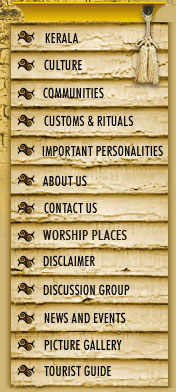|
The Catholic Church in Kerala is now a communion of three major individual Churches: Latin Catholic Church, Syro- Malabar Church, Syro–Malankara Church. The presence of the Latin Church in Kerala has protracted over eleven centuries or more. However, the work of evangelization was enthusiastically revived by the western missionaries in the 13th century. The first instances of these efforts were found to be in Quilon with the visit of a Franciscan priest by name John Monte Carvino who was appointed by the Pope of Rome as Archbishop of Khanbaliq (Peking) and included India as part of that bishopric. He spent some 13 months in Kerala and in the Southern India after landing in Quilon in 1292/93 A.D. . Later in August 1329 the Pope John XXII created the Quilon diocese, the first Latin Catholic diocese in India, with Bishop Jordanus Catalani, a Dominican Friar as its head. The arrival of the Portuguese missionaries in Cochin in 1500 A.D. opened a new regime under the Portuguese Padroado, which was a treaty signed between Pope of Rome and the King of Portugal giving the latter territorial jurisdiction including India for ultimate authority regarding missionary work. Missionaries from different orders, like Franciscans, Jesuits, Dominicans, Augustinians, Carmelites, etc. came to work in India. In 1534 when the Diocese of Goa was established, Cochin was made a part of that Diocese. The Portuguese missionaries found the local Christians of Kerala in serious error in respect of Faith and Practice and, therefore, initiated a Latinization process whereby a large number of the original St. Thomas Christians in Kerala, and almost wholly in Cochin area, found shelter in the Latin Church.
In 1599 Archbishop Alexeo de Menezes of Goa arrived in Cochin and convened a Synod at Udayamperoor, known in Kerala history as the Synod of Diamper, and brought the entire folk of St. Thomas Christians in Kerala under the Roman Catholic hegemony. Already in 1542, Francis Xavier, a Jesuit missionary, had arrived in Goa and started missionary work stretching towards the Southern India, and the conversions he made to Christianity from especially the lower class Hindus, on the sea coasts particularly, were numerous. This situation led to the erection in 1557 by Pope Paul IV the first Roman Catholic (Latin Rite) Diocese in Kochi. In 1663 the Dutch conquered Cochin and expelled all Catholic missionaries and destroyed most of the Catholic churches and institutions in Cochin. The British conquest of Cochin that followed did not also benefit the Catholic Church. In 1838 the Diocese of Cochin came to be governed by the Vicar Apostolic of Verapoly. In 1886 Pope Leo XIII raised the Vicariate of Verapoly to the status of an Archdiocese, with Quilon and Cochin as suffragan dioceses. In 1887, the St. Thomas Christians who were continuing the Syrian Rite under the Latin rule were separated and placed under a different hierarchy. Today, the Latin Catholic Church, with 12 million members, is the largest section of the Christian population of India (24 million). It has at least 113 Dioceses now. Latin Catholics in Kerala number about 20 lakhs with 2 Archdioceses, namely of Verapoly and Trivandrum, and 9 Dioceses.
References:
1.PYLEE, L.M. St. Thomas Christians and the Archdiocese of Verapoly; a short historical study, Ernakulam, St. Joseph’s Industrial School Press, 1977, 459+ pp..
2.GEORGE VELIPARAMBIL. Kerala sabha charithram ; lattheen katholikkar, Trivandrum, Carmel International Publishing House, 2010, 234 pp. (3) CBCI. The Catholic Directory of India, The Jubliee Year 2000 Edition, Delhi, CBCI Centre, 1998, by Comp. by Rev. George S. Pereira, & Ed. by Prof. C.A. Augustine), 1543 pp.).
|



